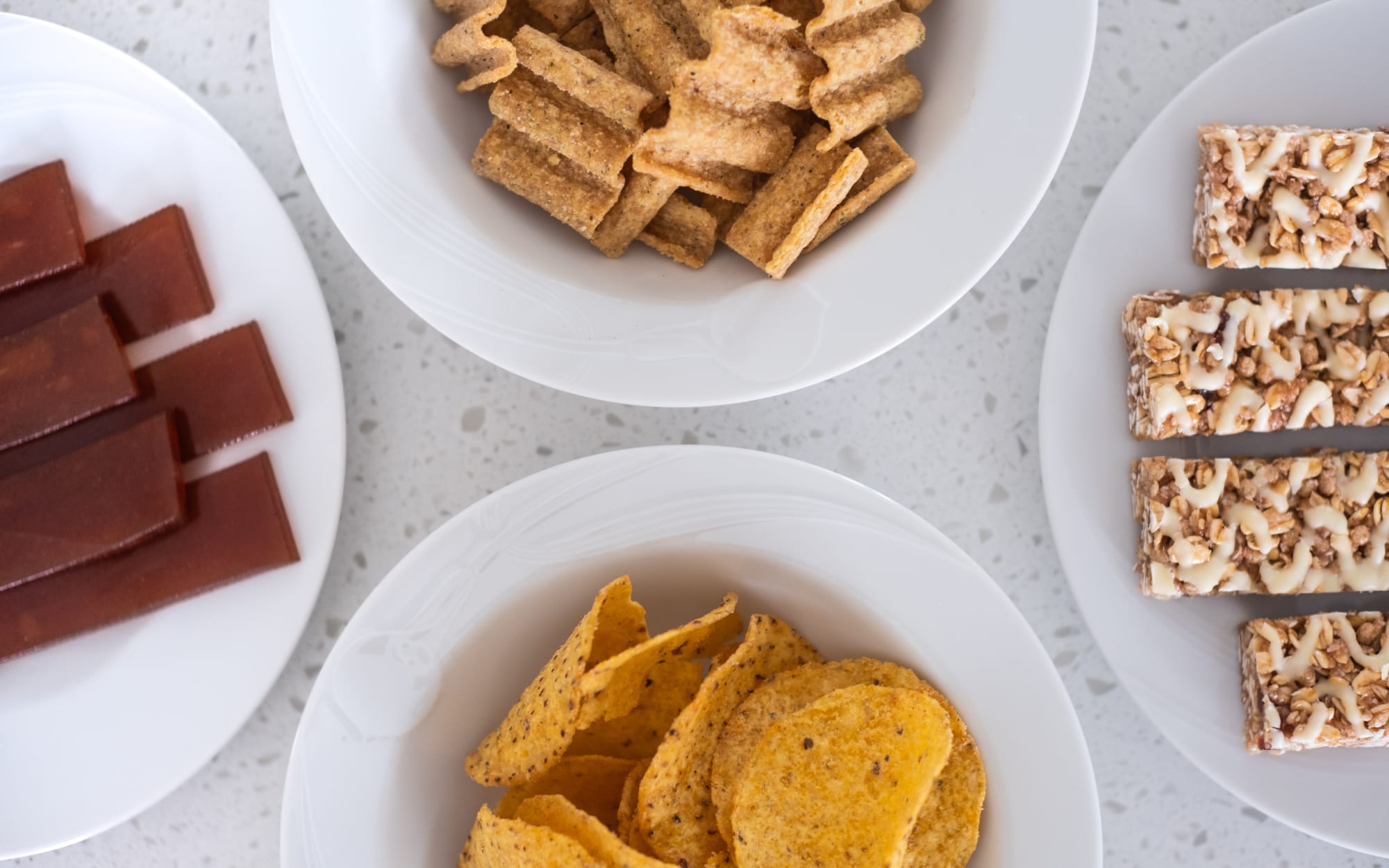Officials say it should be tackled, and experts think it is driving ill health. But the food industry is fighting back in defence of ultra-processed food (UPF).
“It’s not food," says Fernanda Rauber, a Brazilian scientist and food researcher.
"It’s an industrially produced edible substance."
Many of the things we buy at the supermarket and feed our children count as UPFs - Ultra Processed Foods. They've been through industrial processing to make energy-dense, typically packaged items. They're also often nutrient-poor and high in sugar, unhealthy fats and salt.
They've been a focus for the health and nutritional research community for more than a decade. But they have only more recently surged into wider conversations and debate about diet and policy-making.
This is because that decade or so of research has built up a still-growing body of scientific evidence linking UPFs to the global explosion of obesity and also to increasing rates of cancer, diabetes, heart disease and depression.
The debate has now reached Aotearoa, where experts and officials are calling for action. The food industry, however, will not take regulation of UPFs without a fight.
Read more from this series:
- A proposed legal cap on the amount of sugar or salt in food has a surprise supporter
- Ministers were advised taking GST off fruit and vege would not lower prices
What makes a UPF?
According to the Nova classification system, developed in Brazil in 2009, UPFs contain edible substances not used in home kitchens, like protein isolates and cosmetic additives like flavours, colours and emulsifiers.
“UPFs are not simply foods that have been modified by processing but rather edible products formulated from food-derived substances, along with additives that heighten their appeal and durability,” the Global Food Research Programme, University of North Carolina says.
UPFs include packaged snacks, mass-produced breads, margarines and other spreads, cereal, energy bars, yoghurts, sauces, sausages and other reconstituted meat products.
“UPFs are designed and manufactured for maximum profit: they contain low-cost ingredients, have long shelf-lives, are hyper-palatable, and are highly branded and marketed to consumers. They are typically calorie-dense and high in free sugars, refined starches, unhealthy fats, and sodium.”
New Zealand researchers have found that nearly 70 percent of the packaged food sold in our supermarkets meets the UPF classification and that we now consume about half our energy intake from these foods.

Professor Boyd Swinburn Photo: Supplied
The case for regulation
As part of the investigation Off the Shelf: The Quiet Struggle to Stop us Eating Ourselves Sick RNZ has obtained advice the Ministry of Health provided to ministers earlier this year on UPFs.
The advice says targeting UPFs would make the biggest impact on the obesity epidemic.
It says there is too much sugar and salt in the food supply, and regulation is needed to reduce it.
“The largest improvements will be seen by targeting ultra-processed foods, often consumed by children and young people and communities experiencing food insecurity.”
Professor Boyd Swinburn, co-chair of Health Coalition Aotearoa, says the consumption of UPFs is the most convincing argument for the rise in obesity.
“It's by far the most compelling case for a driver which has delivered what we observe in the world: every single country all going up all at the same time.”
Obesity almost tripled worldwide between 1975 and 2016, according to the World Health Organisation.
“To me, it's the only plausible overarching driver of it. Yes, there are other factors that moderate it and have an influence. But this is the big one.”
Swinburn, an endocrinologist and international expert on obesity, says the obesity explosion cannot be explained by diminishing personal responsibility or by a lack of activity and exercise.
“If you look at the other side of the energy balance equation, the physical activity side, our built environment is not changing that fast. Yes, technology and screen technologies have been coming along. But they didn't start really right back there in the ‘70s and ‘80s. So really, it does land on food and something marked has changed since then.”
Multiple scientific papers have shown diets high in UPFs increase the risk of cardiovascular disease, hypertension, cancer and depression.
A study published in Nutrients in 2020 reviewed 43 studies and found 37 of them linked UPF exposure with at least one adverse health outcome. “These included overweight, obesity and cardio-metabolic risks; cancer, type-2 diabetes and cardiovascular diseases; irritable bowel syndrome, depression and frailty conditions.”
A scientific paper, 'Ultra Processed Food Consumption, Cancer Risk and Cancer Mortality', was published in The Lancet in 2023, showing a link between UPFs and cancer. “Every 10% increment in UPF consumption was associated with increased mortality of overall cancer by six percent, breast cancer by 16 percent and ovarian cancer by 30 percent.”
In New Zealand, the direct health care cost of obesity is about $2 billion a year and the indirect cost, such as loss of productivity, is between $7 billion and $9 billion a year, according to 2021 research by Sapere.
Obesity related conditions account for about 18 per cent of all healthy life years lost.
“That's much more than tobacco,” Swinburn says.
“So we should be considering it in the same way that we consider tobacco and alcohol. These are big threats to health.”
Obesity is the leading factor in Type Two Diabetes, suffered by 500 million people worldwide and expected to increase 51% by 2045, becoming the “biggest global epidemic in history,” according to a PWC report, funded by New Zealand diabetes researchers.
About 250,000 New Zealanders have diabetes, which is expected to rise to about 430,000 in 2040.
The lifetime cost of a 25-year-old developing type two diabetes is about $565,000. Diabetes costs New Zealand about $2 billion a year now, which is predicted to reach $3.5 billion in the next 20 years.

Food and Grocery Council chief executive Raewyn Bleakley Photo: RNZ / Cole Eastham-Farrelly
Industry’s UPF counter-claims
The food industry is fighting greater regulation of UPFs and says processed food can actually be good for us.
The Food and Grocery Council (FGC) opposes references to processed food in a new Advertising Standards Authority (ASA) code on food and drink advertising, currently out for consultation.
The draft code says: “A healthy diet consists of foods and drinks that are mostly unprocessed and are low in saturated fat, salt and sugar.”
But the FGC, representing manufacturers and suppliers who generate $40 billion in domestic retail, say advertising guidelines should not tell people to avoid processed food.
“We strongly oppose the use of the term ‘mostly unprocessed’ and would point to the many processed foods that add positive nutrition to New Zealand diets such as yoghurt and breads,” it says. “We strongly recommend that the sentence read: ‘A healthy diet consists of foods and drinks that are mostly low in saturated fat, salt and sugar.’”
The FGC submission says that processed food can be good for us. “Food processing plays an important part in delivering safe, nutritious and affordable foods as research consistently demonstrates.”
Chief executive of the FGC Raewyn Bleakley says telling people to avoid UPFs could have unintended consequences.
“When you look at the level of processing of a food rather than its nutrient value, you could get into serious trouble,” she says. “Infant formula is highly processed, yoghurt, wholemeal bread - a lot of foods that we would not consider to be high salt, high fat, high sugar - is very processed.”
Bleakley, who studied human nutrition at Otago University, says she struggles to accept the concept of UPFs.
“The nutrient value of the food is determined by the nutrients that are in that food - not the level of processing.”
She also defends UPFs on the basis of consumer choice. “People love them and part of the challenge of what we've got in society is that people make choices.”
Highly processed foods also feature in efforts to combat climate change and food insecurity, she says.
“Ruling out processed foods, or genetically modified foods which is another current example which is going to be explored, can constrain yourself in a world that's changing. That's not going to be helpful.”
The idea of UPFs also has its critics in the scientific community.
A scientific paper, 'The Ultra Processed Foods Hypothesis', published in 2022 by Cambridge University Press on behalf of the Nutrition Society, said the concepts of ‘processing’ and ‘ultra-processing’ were not objectively defined.
“The basic idea appears to be that nature is intrinsically friendly to humans and that, therefore, natural foods are intrinsically ‘good’, while any human intervention (with the exception of preparing foods at home) will alter this optimal situation.”

Snack foods on a kitchen bench. Fruit sticks, chips and museli bars. Photo: RNZ / Cole Eastham-Farrelly
Cheap, addictive and long lasting
The idea of Ultra-Processed Foods came out of the Nova classification system developed by Brazilian scientist Carlos Monteiro in 2009.
Nova has four categories. Category one is whole foods. The second category is culinary ingredients - things you wouldn’t eat on their own but use in making food - like oils and sugar and butter.
Category three is processed food but things you can make in the kitchen like bread or cereal.
Category four is UPFs. “They've been broken down and then reformulated within a factory with a whole lot of additives,” Swinburn says. “Some we're familiar with, like sugar, salt, and fat, but a lot of things just appear as numbers on the back of the packet.”
UPF is designed to be consumed quickly without making you full. “It's often dried to give it a long shelf life, which means the calories are very concentrated. So we put in a lot of calories in a short space of time without realising it. It's really tasty so we eat a lot and we keep eating it.”
Swinburn says the way people crave UPFs means there is “quite a strong case for considering these foods as addictive or mildly addictive”.
A 2019 study by the National Institutes of Health in the United States took two groups of people - one on a UPF diet and one on a minimally processed diet - and let them eat as much as they wanted.
The study found that “during the ultra-processed weeks, participants consumed roughly 500 more calories per day” and gained nearly 1kg of fat.
Humans have only been eating UPFs since the mid-20th century and the growth in sales has coincided with global increases in obesity.
Elaine Rush, Emeritus Professor of Nutrition at Auckland University of Technology, says people short on money and time often consume diets high in UPFs. “If you're living in an environment where nutritious food is not available in the right quantities you are more likely to gain weight because poorer food is dense in calories and cheaper and it's going to mean that you will store more fat.”
Rush, who until recently was the scientific director at the New Zealand Nutrition Foundation, says obesity can be intergenerational.
“Larger mothers and fathers tend to have larger children. So it's set down from conception.”
She believes too much emphasis is placed on personal responsibility.
“We're putting too much weight on the individual saying that they have a choice,” Rush says. “You don't have a choice if you're not in the situation where you can access healthy food and have enough money to be able to do that.”



